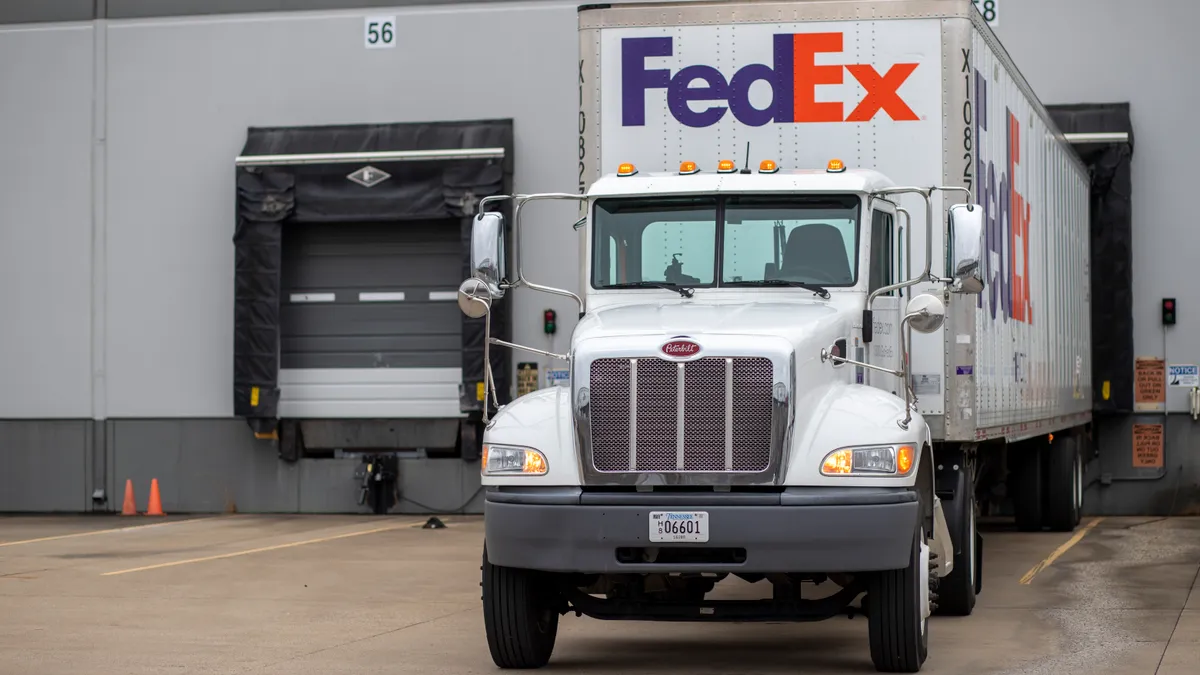Dive Brief:
- Fleets should consider increasing asset utilization, cutting internal costs or diversifying revenue mix to manage risk amid current market volatility, according to the Council of Supply Chain Management Professionals' (CSCMP) State of Logistics Report by Kearney and Penske Logistics.
- "Small to medium-sized carriers with a tight list of customers in highly affected industries will be hit the hardest" by the fallout stemming from the pandemic, according to the report. More than 90% of carriers own fewer than six trucks, and those fleets will "need to think strategically to survive the industry turmoil," the report states.
- "If you can make it through the next six to 18 months, other carriers will drop out, capacity will tighten, rates will rise, and your longer-term outlook will be more stable," the report reads. Not many new trucks will enter the marketplace this year and early next year, the report said, which means there could be a potential "capacity crunch in the second half of 2021."
Dive Insight:
"Whatever [recovery's] shape — 'V,' 'L' or 'swish' — we know that the bulk of the logistics in the U.S., where consumption is some 70% of GDP, is going to have to adapt. And that means further cutbacks by carriers and a rise in bankruptcies, at least in the short term," said Michael Zimmerman, partner at Kearney who presented the report during a webinar Monday.
Comcar declared Chapter 11 bankruptcy in May, and PS Logistics announced plans to acquire its flatbed company soon after. But trucking was facing difficult conditions well before the pandemic. In the first half of 2019, 640 carriers went out of business, more than double the number of closures in all of 2018.
"The bankrupt carriers cited challenges including falling rates and demand, increased tariffs and trade tensions, increased insurance costs, and increased cost of labor to retain drivers," the CSCMP report states. "The deeper a COVID-19-induced recession, the likelier this trend is to accelerate."
Increased cost to retain drivers could be worth it though, according to Stay Metrics. When there is an economic downturn, drivers are less likely to leave their current jobs. But as freight volumes rise and capacity tightens, drivers see opportunity elsewhere and leave carriers for higher rates. "Now is the time to double down on retention efforts," the company's CEO said.
According to CSCMP's report, staying focused on a predetermined network to align shipper commitments can help keep paid miles up. Instead of over-committing capacity to big shippers, the report suggests prioritizing which customers are "most profitable and cohesive with your network."
Using an app could decrease empty miles and boost the chances of future backhauls. This could be especially be useful for smaller carriers, the report said, as they could eliminate some customer acquisition costs.
To cut costs, the report suggests "a well-thought-out technology strategy," including a commitment to investment. Operational efficiency derived from technology could also benefit "traditionally high 'fixed' costs," such as labor. For example, fleets can use technology to move from static to dynamic routing, which has become more important during the pandemic.
On the shipper side, experts recommend a diverse carrier mix to provide more flexibility. The CSCMP report gives similar advice to carriers: "You can diversify your customer mix to rely more on fluid, rapid-response e-commerce flows and less on traditional, scheduled, retail and industrial flows."
The report used J.B. Hunt as an example, as its business mix drove 2019 profit growth. On an April earnings call, CEO John Roberts said the company was "pivoting resources within and across segments." J.B. Hunt's food-related business went up 16% and agricultural deliveries were "consistent" during the quarter ending March 31, while business regarding office furniture and automotive supplies fell.
For firms that may rely primarily on one-way contracts, the CSCMP report suggests expanding dedicated fleet offerings to strengthen customer relations and create a more predictable revenue stream.
Matt Leonard contributed to this report.












